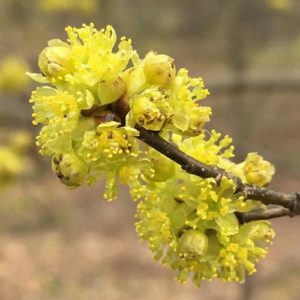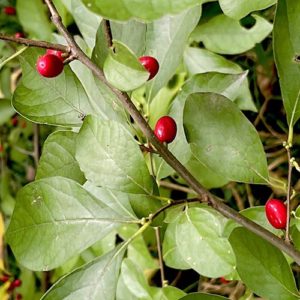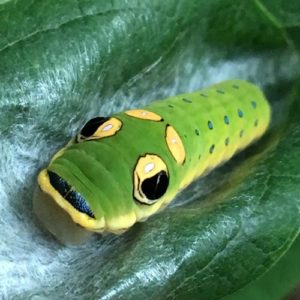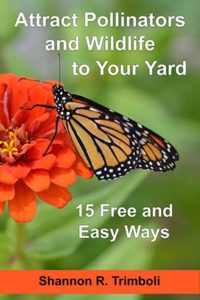By: Anthony Trimboli
When we think of native shrubs that have four season interest the hollies often come to mind. Their bright red berries, spring bloom and foliage are all hard to beat when it comes to looking good in the landscape. But there is another alternative to the hollies that has many of the same aesthetic benefits and is also excellent for pollinators and wildlife.

Spicebush (Lindera benzoin) is a shrub that blooms early, provides an early source of nectar and pollen to native bees, is a host plant for several stunning butterflies and moths, has fruits birds and mammals love, and looks good 12 months out of the year!
What’s in a Name?
Spicebush, as the name suggest has a spicy smell when the leaves, twigs, or fruits are crushed. The leaves, twigs and fruits also have a spicy taste reminiscent of allspice. All parts of the plant are edible, although quite strong tasting, and it was used as a spice and herbal medicine by both the Native Americans and the early settlers.
Biology and Life History
Spicebush is found growing across most of the eastern United States as an understory shrub in rich, moist woods. Although it is mostly found growing in the shade, it can also be found in sunnier locations. It is a large shrub and can reach 6 to 12 feet tall with a 6 to 8 foot spread.
In early spring, around March or April depending on location, small yellow flowers appear in clusters along the stems. The blooms appear before the leaves, and although small, are quite noticeable. Spicebush is dioecious, meaning male and female flowers occur on separate plants.

Throughout the summer, fruit that start out looking like little, green B-Bs develop from the fertilized female flowers. In late summer and early fall, the fruit ripens and turns bright red. These red fruits are eaten by birds and mammals. The seed can survive the trip through the animal’s digestive system and is deposited in a new location, complete with a fertilizer application. This is the main way that new spicebush colonies are created. Existing colonies can increase in size through clonal root sprouts.
Pollinator and Wildlife Uses
Spicebush flowers are pollinated by several species of small flies and bees and the early bloom can be an important source of nectar and pollen for them. Few butterfly and moth species utilize the flowers since the bloom occurs before most are flying.
Despite this, spicebush is still a very valuable plant for butterflies and moths. The leaves are the primary food for several caterpillar species. The caterpillars of the spicebush swallowtail and the Promethea silkmoth are two of the most common species that use spicebush as a host plant.
A wide variety of songbirds and game birds eat the bright red fruits, as do many species of mammals such as raccoons, opossums and squirrels. Deer and rabbits will also occasionally browse the leaves, but it isn’t a preferred plant for either.

Incorporating Spicebush into Your Yard
There is a growing interest in incorporating native plants into gardens and home landscaping plans. Often, this interest focuses on native wildflowers. However, spicebush is a great example of a native shrub that can easily be grown as a native landscape shrub or small tree in semi-shady lawns. Spicebush provides year-round interest and valuable backyard wildlife habitat.
Its early, yellow flowers make it a natural replacement for forsythia shrubs. Like forsythia, it can create a hedge; however, it doesn’t spread nearly as fast as forsythia or require the frequent pruning forsythia does.
Spicebush leaves are a medium green and create a nice backdrop to other landscape plants during the summer. In the fall, spicebush leaves turn a brilliant yellow creating a pretty contrast with the red berries.
The berries will persist into winter after the leaves drop providing winter interest until they are eaten by the birds and other critters. However, only the female trees produce berries and there is no way to tell whether a spicebush grown from seed is a male or female plant until it flowers. Therefore, planting multiple spicebush plants is always recommended in order to a) increase your chances of getting a female plant that will produce berries, and b) to increase your chances of having both male and female plants to ensure pollination.
One thing to be aware of with spicebush is that it is susceptible to laurel wilt disease. Laurel wilt disease is caused by an introduced fungal pathogen that can affect all members of the Lauraceae family which, in addition to spicebush, includes sassafras, redbay, and the agriculturally significant but non-native avocado. Therefore, if you are in an area that has been impacted by laurel wilt disease understand that spicebush planted in your landscape may become infected with laurel wilt and die.
Summary
Spicebush is an excellent native shrub to add to shadier areas of the home landscape. It is well behaved and won’t spread quickly or require frequent pruning. The early blooms provide nectar and pollen for native bees and flower flies, while the showy, glossy green foliage is used by several butterfly and moth species. In addition, the bright red fruits are a hit with the birds and other critters. A huge bonus is deer and rabbits generally leave it alone! The benefits of spicebush to wildlife and pollinators coupled with the 12-month visual interest and low maintenance make it tough to beat.

Do you want to make your yard more pollinator and wildlife friendly, but aren’t sure where to start?
Check out my book, Attract Pollinators and Wildlife to Your Yard: 15 Free and Easy Ways, for some easy, quick wins to get you started.

Backyard Ecology: Exploring Nature in Your Backyard
Nature isn’t just “out there.” It’s all around us, including right outside our doors. Hi, my name is Shannon Trimboli, and I am the host of Backyard Ecology. I live in southcentral Kentucky and am a wildlife biologist, educator, author, beekeeper, and owner of a nursery specializing in plants for pollinators and wildlife conservation. I invite you to join me as we ignite our curiosity and natural wonder, explore our yards and communities, and improve our local pollinator and wildlife habitat. Learn more or subscribe to my email list at www.backyardecology.net.

Leave a Reply